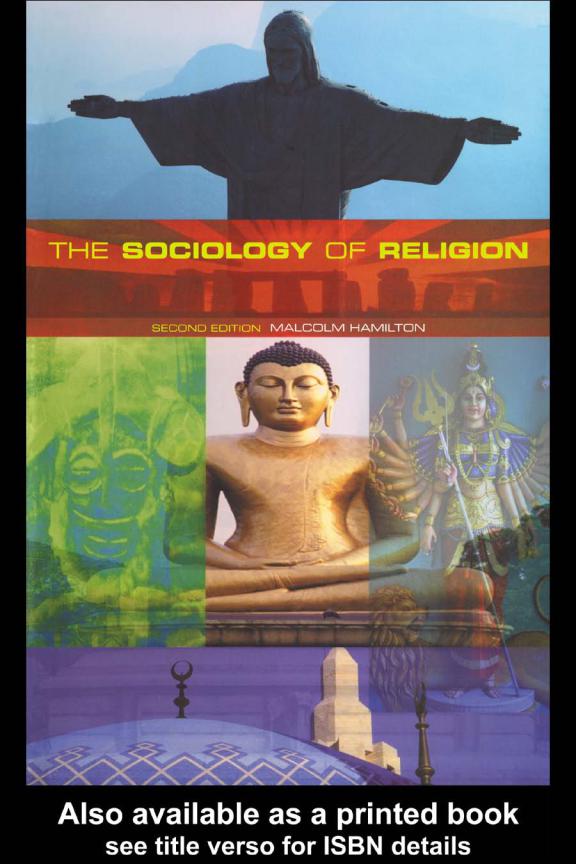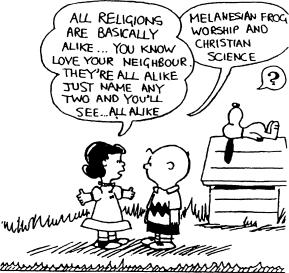
- •preface to the second edition
- •Introduction
- •Religion and reason
- •Magic
- •Religion and emotion
- •Buddhism
- •The coming of the millennium
- •The birth of the gods
- •Taboos and rituals
- •Religion and meaning
- •Secularisation
- •Religion and rational choice
- •Sects, cults and movements
- •Conclusion
- •Notes
- •Bibliography
- •Index

The Sociology of Religion
This expanded second edition of The Sociology of Religion provides a clear and comprehensive discussion of theoretical perspectives in relation to a wide range of substantive issues illustrating the diversity of religion. Offering a broad comparative view, Malcolm Hamilton draws on the insights of history, anthropology and sociology, surveying classic and contemporary theory to give a full picture of their variety and scope and how they relate to particular beliefs and practices. Inclusion of current debates and research findings brings this edition fully up to date in every respect. The chapters on secularisation and religious sects and movements have, in particular, been extended to incorporate recent work and developments. Both include fuller consideration of the contributions of rational choice theorists and their critics on questions such as the relationship between religious pluralism and conditions prevailing in the religious ‘market place’. The chapter on sects and movements, which includes a new section on conversion, provides an extended discussion of earlier work on the nature of sectarianism as well as new insights that studies of a diverse range of religious and related movements have generated.
Malcolm Hamilton is Senior Lecturer in the Department of Sociology at the University of Reading. Other publications include Sociology and the World’s Religions, Democratic Socialism in Britain and Sweden and Class and Inequality in Comparative Perspective.

The Sociology of
Religion
Theoretical and comparative perspectives
Second Edition
Malcolm Hamilton
London and New York
First published 1995 by Routledge
11 New Fetter Lane, London EC4P 4EE
Second edition first published 2001 Simultaneously published in the USA and Canada by Routledge
29 West 35th Street, New York, NY 10001
Routledge is an imprint of the Taylor & Francis Group
This edition published in the Taylor & Francis e-Library, 2002.
© 1995, 2001 Malcolm Hamilton
All rights reserved. No part of this book may be reprinted or reproduced or utilised in any form or by any electronic, mechanical, or other means, now known or hereafter invented, including photocopying and recording, or in any information storage or retrieval system, without permission in writing from the publishers.
British Library Cataloguing in Publication Data
A catalogue record for this book is available from the British Library
Library of Congress Cataloging in Publication Data
Hamilton, Malcolm (Malcolm B.)
The sociology of religion : theoretical and comparative perspectives / Malcolm B. Hamilton. – 2nd ed.
Includes bibliographical references and index. 1. Religion and sociology. I. Title.
BL60 .H265 |
2001 |
306.6–dc21 |
2001019300 |
ISBN 0-415-22666-X (hbk)
ISBN 0-415-22667-8 (pbk)
ISBN 0-203-00861-8 Master e-book ISBN
ISBN 0-203-19144-7 (Glassbook Format)
Contents
preface to the second edition |
vii |
|
1 |
Introduction |
1 |
2 |
Religion and reason |
25 |
3 |
Magic |
37 |
4 |
Religion and emotion |
55 |
5 |
Buddhism |
82 |
6 |
Religion and ideology: Karl Marx |
91 |
7 |
The coming of the millennium |
98 |
8 |
Religion and solidarity: Emile Durkheim |
109 |
9 |
The birth of the gods |
122 |
10 |
Religion and solidarity: the functionalists |
130 |
11 |
Taboos and rituals |
140 |
12 |
Religion and rationality: Max Weber |
165 |
13 |
The Protestant ethic debate |
165 |
14 |
Religion and meaning |
177 |
vi |
Contents |
|
15 |
Secularisation |
185 |
16 |
Religion and rational choice |
215 |
17 |
Sects, cults and movements |
229 |
18 |
Conclusion |
272 |
Notes |
276 |
|
Bibliography |
283 |
|
Index |
303 |
|
Preface to the second edition
Despite the often bemoaned fact among sociologists of religion that their subdiscipline tends to be treated as peripheral, a remarkable amount of work has been carried out and published since the first edition of this book appeared. Debates have also been noticeably intense and animated and there appears to be no sign at all of the sub-discipline fading away as some had once feared.
This second edition has been extensively revised and expanded to bring it up to date with current debates and research findings. The debate concerning secularisation, for example, has been particularly vigorous and the chapter on this topic has been extended accordingly. Alongside secularisation, the emergence of the new religious sects and movements has for long been a prominent, perhaps even more prominent, issue in the sociology of religion, but although the former has in the last few years perhaps taken over the position of the latter as the topic that has attracted most attention, religious sects and movements have far from lost the fascination they have always held. This second edition allows a fuller discussion of earlier work on the nature of sectarianism and studies of new religious sects and movements as well as consideration of new work and material which have appeared in the last few years, including the addition of a new section on conversion.
Both the secularisation debate and work on the new religious movements have received close attention from rational choice theorists and this edition includes more detailed consideration of the recent contribution that this theoretical perspective has made and of its critics, and in particular of questions such as the relationship between religious pluralism, on the one hand, and the conditions that prevail in the religious ‘market place’, on the other.
The fact that it is the topics of sectarianism and secularisation that have required the most extensive updating would seem to reinforce the accusation that has sometimes been made that the sociology of religion has been largely preoccupied with this narrow range of subject matter and, even then, largely in a Christian context. While this continues to ring true, developments in other areas, most notably within the sphere of anthropology, have been significant. In accordance with one of the key aims of the book, namely to cut across disciplinary frontiers, the chapter on ritual which makes extensive use of anthropological work has, in consequence, been substantially filled out.
viii Preface to the second edition
Also, developments in theoretical perspectives other than rational choice theory show healthy signs, particularly with regard to cognitive approaches which now receive fuller treatment here in Chapter 2.
The rather narrow focus of the sociology of religion upon the Christian world can, perhaps, be explained by the sheer diversity of potential subject matter and the daunting nature of the task of attempting to encompass it. No form of social activity or set of social institutions comes in quite the bewilderingly diverse variety that is characteristic of religion. In no other sphere, consequently, are sociologists, anthropologists, psychologists and other social scientists presented with such seemingly intractable and puzzling problems of understanding. True, anthropologists have shown us how remarkably variable are such things as kinship systems and family patterns. These aspects of social life are such that the particular forms of them with which we happen to be familiar are usually so taken for granted as absolutely normal that deviations from them in other societies appear almost incredible. Anthropologists, however, assure us of their sheer normality in their own context. Kinship systems and family structures, however, can only come in a limited variety of forms. Not so religious beliefs and practices, the profusion of forms of which defies the capacity of any single scholar to comprehend, unlimited as they are by material constraints. Also, new ones continue to germinate while both old and new continuously transmute and evolve.
Earlier theorists, however, were less daunted by this diversity and complexity, casting their net much more widely than is common today. Spencer, Tylor and especially Frazer drew upon as diverse a range of material as they could lay their hands upon. Durkheim based his entire theoretical treatise on religion on ethnographic data pertaining to the aboriginal people of Australia. Freud relied for ethnographic detail in his studies on the subject to a considerable extent on the work of Frazer. The early functionalists such as Malinowski and RadcliffeBrown were anthropologists who had first-hand fieldwork experience of societies very different from their own. Max Weber’s scholarship in the world religions is proverbial. For this reason, as this book seeks among other things to demonstrate, all these theorists continue to have a fair measure of relevance today.
This book seeks to recapture the theoretical legacy of these scholars, based as it was upon a comparative perspective taken for granted in their day as essential for the successful objective study of human social systems but which today has become all too rare. In broadening the discussion of both rational choice and cognitive theoretical approaches, one of the primary aims of the first edition is thereby strengthened. The story is brought fully up to date in setting out the most influential recent theoretical approaches alongside the classical approaches, revealing their linkages and the extent to which the former have attempted to synthesise and build upon the insights of the latter. It has to be acknowledged, however, that in this field, as in so many in what is still a relatively new subject like sociology, we remain at a rudimentary state of knowledge and understanding.
Theoretical discussion and debate alone and without reference to substantive issues, are of course, sterile. The purpose of theory is to promote understanding
Preface to the second edition ix
of the substantive. The original structure of the book is, consequently, unchanged with the various theoretical approaches treated in conjunction with substantive questions. Each chapter devoted to a theoretical perspective is followed by one on a substantive issue. The substantive themes which follow each theoretical chapter in this way have been chosen with their particular appropriateness in mind and are intended to illustrate the application of the theories and the way in which they have been used to throw light upon specific and concrete aspects of religion. The range of substantive issues covered also serves to provide a series of topics illustrating the diversity of religious conceptions and actions. They include discussion of anthropological literature pertaining to ‘primitive’ or tribal societies and a major non-Western world religion, namely Buddhism, as well as various aspects of the Christian tradition.
Arrangement of the material in this way will hopefully facilitate understanding of theory but, in order to get an overview of the range of theoretical perspectives, some readers may prefer to read all the chapters dealing with theories first, that is starting at Chapter 1 and all the even numbered chapters, returning to the substantive chapters later.
This book has grown out of many years teaching the sociology of religion at the University of Reading, during which time I have incurred many debts to my colleagues there as well as many others elsewhere. I would like to thank all those who have commented upon and made various suggestions for the second edition and hope that I have paid sufficient attention to them that they and others will find this an improved and useful volume.

